Articles
- Page Path
- HOME > Korean J Community Nutr > Volume 18(3); 2013 > Article
-
Original Article
- Development of Dietary Life Education Textbook and Teaching Manual for Creative Activities in Elementary School
- Eun Sil Her
-
Korean Journal of Community Nutrition 2013;18(3):203-212.
DOI: https://doi.org/10.5720/kjcn.2013.18.3.203
Published online: June 30, 2013
Department of Food and Nutrition, Changshin University, Changwon, Korea.
- Corresponding author: Eun Sil Her, Department of food and nutrition, Changshin University, Changwon 630-764, Korea. Tel: (055) 250-1203, Fax: (055) 250-1200, heres@cs.ac.kr
• Received: March 27, 2013 • Revised: May 6, 2013 • Accepted: June 12, 2013
Copyright © 2013 The Korean Society of Community Nutrition
This is an Open-Access article distributed under the terms of the Creative Commons Attribution Non-Commercial License (http://creativecommons.org/licenses/by-nc/3.0/) which permits unrestricted non-commercial use, distribution, and reproduction in any medium, provided the original work is properly cited.
- 429 Views
- 3 Download
- 1 Crossref
Abstract
- This study was conducted to develop a dietary life education textbook and teaching manual for creative activities of elementary school students in middle grade. First, we extracted dietary life related contents from textbooks for third and fourth grade and created systematization of contents involving educational objectives, goals, contents and activities. The development of textbook and teaching manual were based on systematization of contents. The textbook was composed of five major chapters, which were 'nutrition', 'cooking', 'environment and hygiene', 'food' and 'dietary culture'. Each major chapter having six to seven smaller chapters, adding up to a total of 34 smaller chapters. The textbook was in activity format so that can be readily and directly used in actual classes. The textbook had fun characters and various activities (particularly a lot of cooking activities) to deliver the main theme of each chapter. The teaching manual was composed of background, goal, teaching plan and teaching point. The smaller chapters had learning goal, teaching-learning resources, important points, teaching-learning process and reference material. In evaluation after operating the model school, the developed textbooks were suited for students' needs and cognitive level. This textbook can be utilized at creative activities consisting of ten to fifteen students.
- 1. Cheong HS, Lee JS. Study on nutrition education and perception of nutrition teachers and dietitians in Gyeongnam area. Korean J Food Cookery Sci 2012; 28(3): 229-240.Article
- 2. Cho MK, Lee KH, Lee KA, Lee SS, Kim YK, Her ES. Development of contents and textbooks for the education to reduce elementary students' natrium intake. Korean J Nutr 2009; 42(6): 567-576.Article
- 3. Choi EY. Development of nutritional education program for nutrition teacher in elementary school. Seoul: Sookmyung Women's University press; 2005.
- 4. Her ES. Development of practical dietary education textbook and teaching manual in elementary school students. Korean J Community Nutr 2010; 15(5): 636-647.
- 5. Her ES. Eating behavior, nutrition knowledge and educational needs of the food and nutrition of elementary school students in the Gyeungnam province. Korean J Community Nutr 2013; 18(1): 11-24.Article
- 6. Chang SO, Lee OH, Lee KS. Intake of processed foods and the effects of nutrition label education in 5th grade children. J Korean Diet Assoc 2008; 14(2): 166-175.
- 7. Jeon SK. Educational meanings and effective practical plans of school dietary life education. J Korean Home Econ Educ Assoc 2010; 22(1): 117-135.
- 8. Jo MA. A study on dietary habits and development of teaching-learning curriculum of nutrition education for obese elementary school children. Changwon: Changwon National University press; 2007.
- 9. Kim HH, Park YH, Shin EK, Shin KH, Bae IS, Lee YK. Students's and parents's perceptions of nutrition education in elementary schools. J Korean Soc Food Sci Nutr 2006; 35(8): 1016-1024.
- 10. Kim JH, Jeon SK. A study on the systematization of contents and textbook analysis for school dietary education in elementary school. J Korean Home Econ Assoc 2010; 48(9): 1-12.
- 11. Kim JY, Sim KH. The actual conditions and recognition of dietary life education in elementary school after execution of the dietary life education support act. Korean J Food Nutr 2011; 24(3): 295-305.Article
- 12. Kim JY, Sim KH. A survey on dietary education needs for implementing dietary education by teachers in elementary schools. Korean J Food Cookery Sci 2012; 28(2): 183-193.Article
- 13. Kim KA, Lee YK. The effect of nutrition education using animations on the nutrition knowledge, eating habits and food preferences of elementary school students. Korean J Community Nutr 2010; 15(1): 50-60.
- 14. Kim SH, Choi EH, Lee KE, Kwak TK. Effects of nutrition education on food waste reduction. J Korean Diet Assoc 2007; 13(4): 357-367.
- 15. Kim YH, Jang MR. A research on analysis of eating habits and textbook contents for efficient nutrition education of elementary school students in Gangneung city. J Korean Diet Assoc 2007; 13(4): 379-388.
- 16. Kim YK, Kim JY, Cha MH, Lee KA, Lee SS, Lee KH. Development of contents and textbook for the education to reduce elementary students' fat intake. Korean J Community Nutr 2009; 14(2): 158-167.
- 17. Korea Agency of Education, Promotion and Information Service in Food, Agriculture, Forestry and Fisheries. Available from http://www.epis.or.kr. 2013; cited 2013 March 14.
- 18. Kyeon YK. Application of practical nutrition education program for the improvement of dietary habits and attitudes of elementary students. Seoul: Seoul National University press; 2006.
- 19. Lee KA. Activity-based nutrition education for elementary school students. J Korean J Nutr 2003; 36(4): 405-417.
- 20. Lee KH, Her ES, Woo TJ. Development of nutrition education textbook and teaching manual in elementary school. J Korean Diet Assoc 2005a; 11(2): 205-215.
- 21. Lee YM, Lee MJ, Kim SY. Effect of nutrition education through discretional activities in elementary school. J Korean Diet Assoc 2005b; 11(3): 331-340.
- 22. Ministry of Education, Science and Technology. 2007, 2009 revised curriculum. 2013; cited 2013 March 14]. Available from http://cutis.mest.go.kr.
- 23. Ministry of Government legislation. Dietary life education support act. 2009; cited 2013 March 14]. Available from http://www.law.go.kr/main.html.
- 24. Ministry of Health and Welfare. Report on 2011 national health and nutrition survey. 2012; cited 2013 March 13]. http://www.khidi.or.kr.
- 25. Park SD. Impact of self-concept promotion program on the learning attitude and sociability of lower graders in elementary school. Cheonan: Baekseok University press; 2007.
- 26. The Korean Dietetic Association. Our food culture learning interestedly. 2006; cited 2013 March 14]. Available from http://www.dietitian.or.kr.
- 27. Weiss EH, Kien CL. A synthesis of research on nutrition education at the elementary school level. J School Health 1987; 57(1): 8-11.ArticlePubMed
- 28. Yoon HJ, Yoon KS. Elementary school students' knowledge, behavior and request for education method associated with food safety. J Korean Diet Assoc 2007; 13(2): 169-182.
- 29. Yun JS, Lyu ES. Satisfaction and perception of nutrition education by elementary school students. J Korean Soc Food Sci Nutr 2012; 41(9): 1259-1264.Article
REFERENCES
Figure & Data
REFERENCES
Citations
Citations to this article as recorded by 

- The Development of a Nutrition Education Program for Low-income Family Children by applying the Social Cognitive Theory and Health Belief Model
Saes-byoul Lee, Yu-Ri Jeong, Hyo-Jin Ahn, Min-Ji Ahn, Su-A Ryu, Nam-E Kang, Se-Young Oh
Korean Journal of Community Nutrition.2015; 20(3): 165. CrossRef
Development of Dietary Life Education Textbook and Teaching Manual for Creative Activities in Elementary School
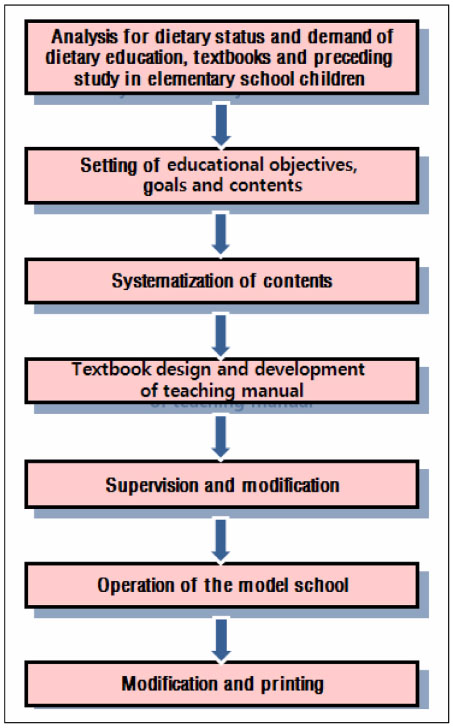
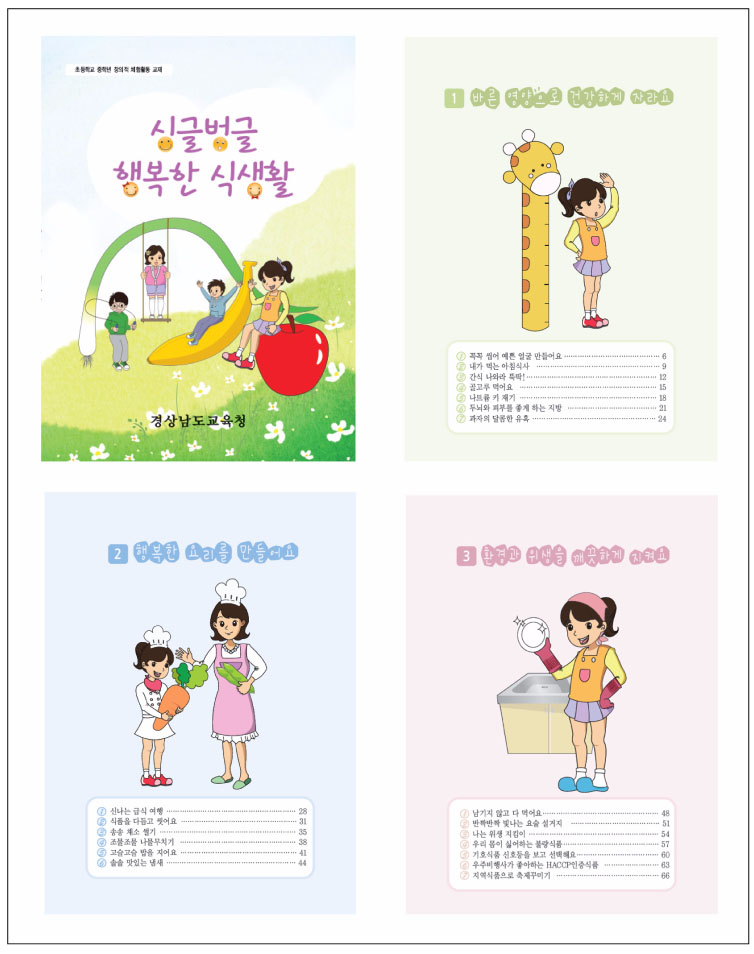
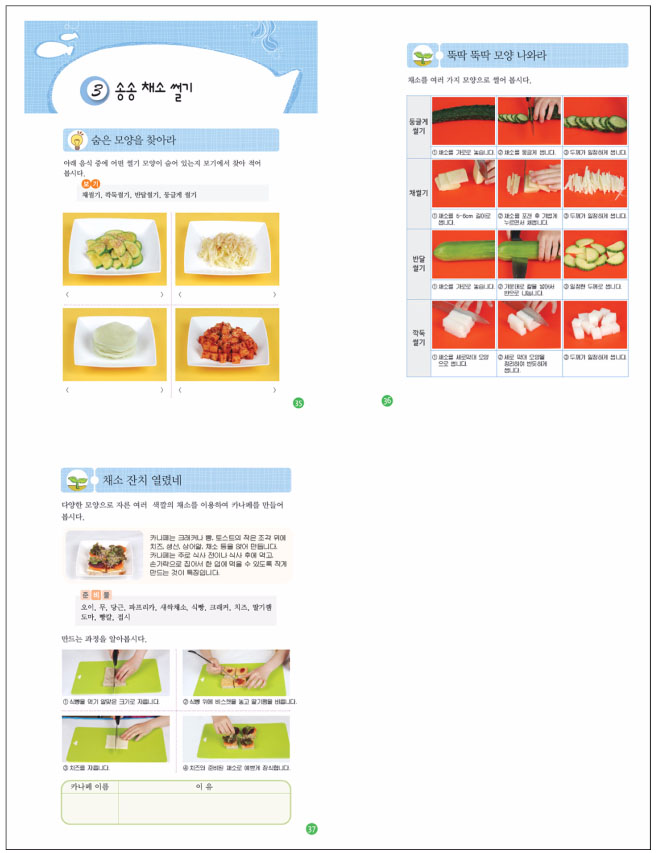
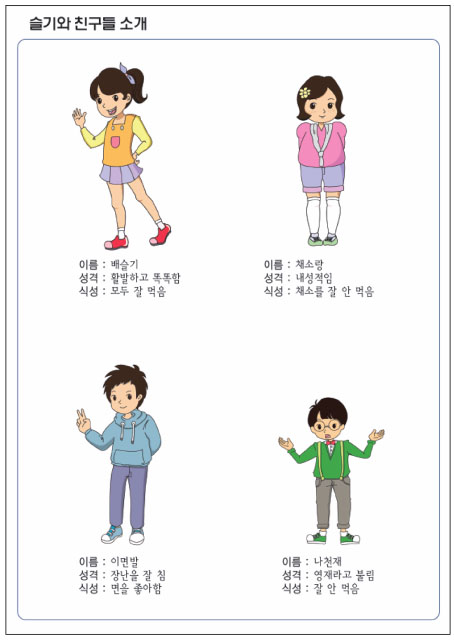

Fig. 1
Development process of textbook and teaching manual.
Fig. 2
The examples of cover and major chapter page.
Fig. 3
The example of representative small chapter.
Fig. 4
Character introduction.
Fig. 5
The example of teaching plan.
Fig. 1
Fig. 2
Fig. 3
Fig. 4
Fig. 5
Development of Dietary Life Education Textbook and Teaching Manual for Creative Activities in Elementary School
Systematization of contents
Evaluation for the developed textbook
Table 1
Systematization of contents
Table 2
Evaluation for the developed textbook

 KSCN
KSCN





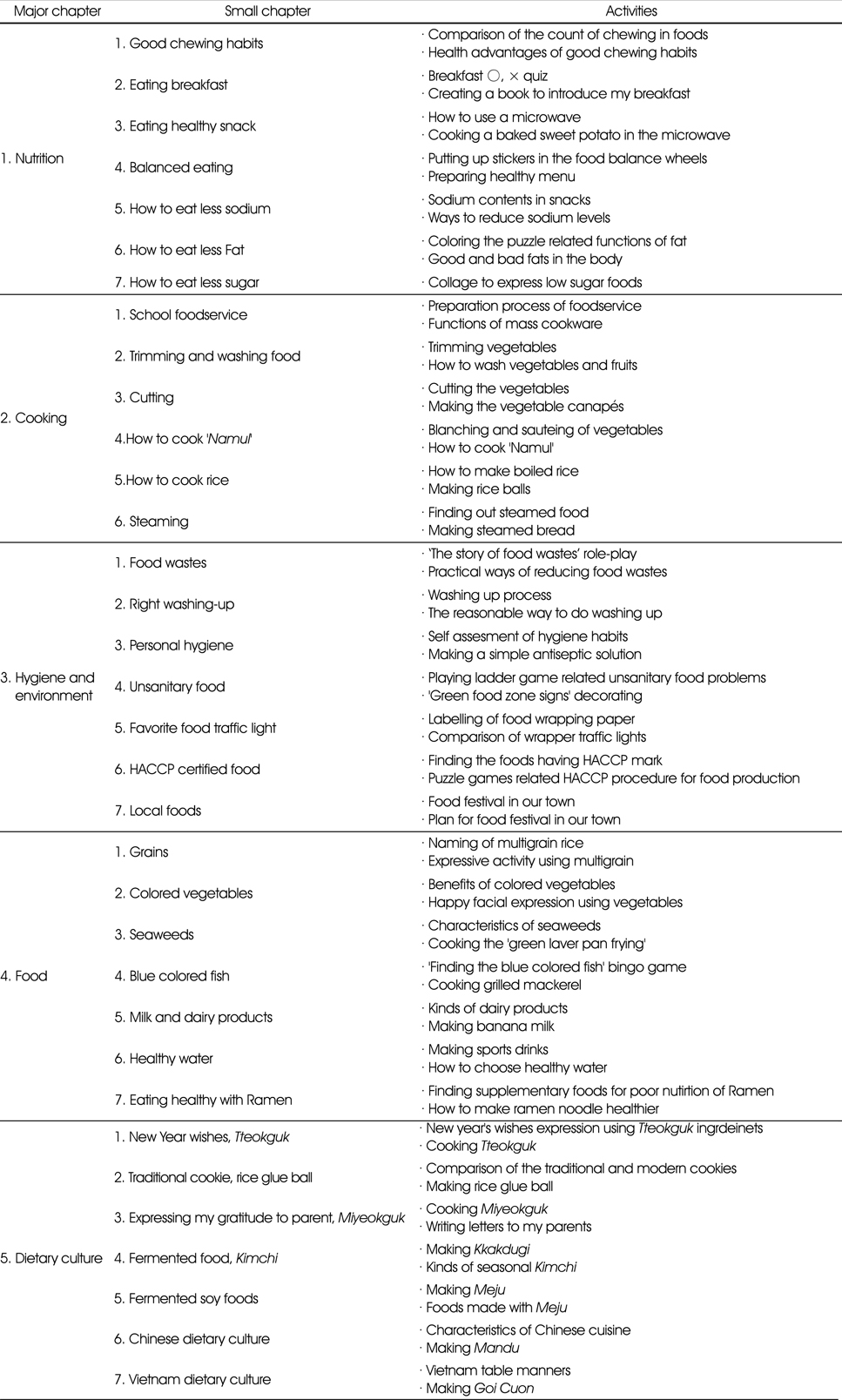
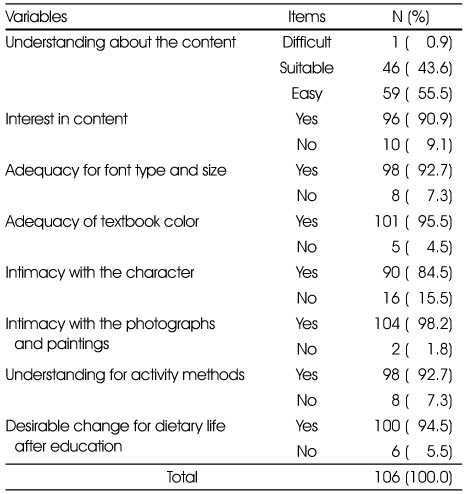
 PubReader
PubReader Cite
Cite


